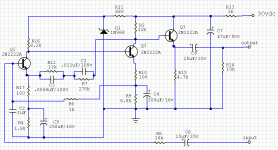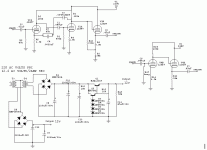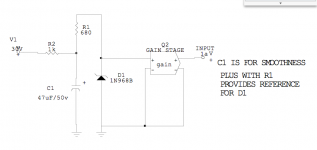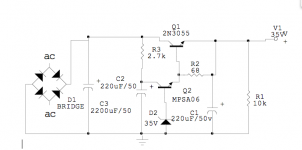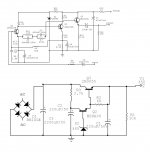 Thread split from http://www.diyaudio.com/forums/tubes-valves/156564-need-good-phono-stage-design.html
Thread split from http://www.diyaudio.com/forums/tubes-valves/156564-need-good-phono-stage-design.html___________________________________________________________________
Phono preamps, Phono preamps.
Everyone wants a "good" phono preamp. And it must be tubes. Why..., must it be tubes, is my question.
I have been in electronics since 1952. And not once, have I a seen a great tube preamp; that did not require re-tubing.
Re-tubing a tube preamp, removes the balance and the smooth tones that was once its signature. You will spend large sums of money trying to get that sound again, that will never return. It will be close, but no cigar. Never! Again.
Why, because tubes are not made equal. The grid is the secret to its sound. And they are never made the same. Believe me..., I know. I worked at GE and Tung-Sol tube factories. And it does not matter what you do or how hard you look.
So I will tell you a great secret, one that very few know.
There is only one great phono preamp. And I designed and built it for the US Government in 1961. And it uses only three transistors. A transistor that was designed in 1956. That is still made today, for as low as 3 cent each per 100.
When I was young, I went to Bell labs, and met the people that were designing transistor chips for many other companies. They were starting to make silicon units. They gave me what they called the greatest transistor ever. They told me that thousands of different transistors will come after it, and people will over look its outstanding values, because they will misunderstand it. Or they will misunderstand its data values or they would not know how to read a transistor data sheet.
My the phone preamp used three 2N2222A. It is very, very quite.
You may being thinking, I am crazy. Yet allow me to lay some facts on you.
a. the max. noise level of a 2N2222A, is 4db. No more
b. its dc current gain is 50 to infinite, at 10na/10volts
c. its dc current gain is 75 to 325, at 1.ma/10volts. Which is much better than some of the more new transistor designs for high gain. Believe me, any thing above 375 in gain, is only better noise level. Not a better transistor. And its real Vceo is 50 volts, not 40 volts.
Once it is built, you will never want for another preamp. Because you will never lose that smooth warm tones of a 2N2222A. Will not believe your ears.
email me, if you are serious into audio, and I will send you the pcb. It is in CircuitMaker 2000 format.
Take Care
Ivey
Last edited:
Phono Pre Amp
I am posting the drawing of the phono preamp.
But remember. Everyone.
This is a simple phono preamp. It was designed in the early 1960's. To us back then, it was something new. We kept it simple and clean.
I post this preamp not to show how smart we were. But to give people a look see as to how far we have come, from those early today in transistor technology.
Keeping it simple, is a very important issue. Us older guys remember when working on our chevys and fords was a pleasure. Because they were so simple to care for. Not like today, where you need a computer to assist you..., in telling you the door is open.
This is blast from the past. Showing that with a hand full of parts, that you can get at your local Radio Shack today. You can put a phone preamp together without pulling your hair out or wondering what all those blasted transistors are for. And do it for about $10.00 dollars.
To comment about the P-59. It was at Edwards AirBase, Calif. It flew and handled like a stone. Lockheed was given 6 to 10 months to come up with a better working design and plane. The engine that the Brits gave us was under powered and the P-59 was too heavy.
So they dropped the weight and trimmed it down and out came the P-80.
A better solution to a bad problem.
These drawing are uploaded as doc. But you first download the file. Put CircuitMaker 2000 extentions on the file. And open it up in CircuitMaker 2000. The pcb file is layout as an exploded view to let new comer to pcb layout get an idea as to how to began. But in truth, you can do as you wish.
Take Care
Ivey
I am posting the drawing of the phono preamp.
But remember. Everyone.
This is a simple phono preamp. It was designed in the early 1960's. To us back then, it was something new. We kept it simple and clean.
I post this preamp not to show how smart we were. But to give people a look see as to how far we have come, from those early today in transistor technology.
Keeping it simple, is a very important issue. Us older guys remember when working on our chevys and fords was a pleasure. Because they were so simple to care for. Not like today, where you need a computer to assist you..., in telling you the door is open.
This is blast from the past. Showing that with a hand full of parts, that you can get at your local Radio Shack today. You can put a phone preamp together without pulling your hair out or wondering what all those blasted transistors are for. And do it for about $10.00 dollars.
To comment about the P-59. It was at Edwards AirBase, Calif. It flew and handled like a stone. Lockheed was given 6 to 10 months to come up with a better working design and plane. The engine that the Brits gave us was under powered and the P-59 was too heavy.
So they dropped the weight and trimmed it down and out came the P-80.
A better solution to a bad problem.
These drawing are uploaded as doc. But you first download the file. Put CircuitMaker 2000 extentions on the file. And open it up in CircuitMaker 2000. The pcb file is layout as an exploded view to let new comer to pcb layout get an idea as to how to began. But in truth, you can do as you wish.
Take Care
Ivey
Attachments
Last edited:
The Moderator is Correct
To all, I must say that I did it again. I screwed up the upload to the drawing. But I managed to work it out. I am re-posting the complete drawing.
The Phono Preamp and the LineAmp are mere simple circuits. They are not for the purpose of dazzling people with my skills or knowledge.
They are to provide a stepping stone for those who want to try out something new, different, and inexpensive. As a building block per say.
Most parts are easy to obtain, from Radio Shack, Mouser, and local Hamfest markets. With luck, it could be built (a stereo unit) for about $25.00 dollars.
You can use 120 volt transformers with a voltage doubler, for the HV.
The MJE13007, can be replaced with even another MPSA42 with a heatsink.
It may run warm. But it is a hobby. Burn it up. Start all over again.
Take Care.
Ivey
To all, I must say that I did it again. I screwed up the upload to the drawing. But I managed to work it out. I am re-posting the complete drawing.
The Phono Preamp and the LineAmp are mere simple circuits. They are not for the purpose of dazzling people with my skills or knowledge.
They are to provide a stepping stone for those who want to try out something new, different, and inexpensive. As a building block per say.
Most parts are easy to obtain, from Radio Shack, Mouser, and local Hamfest markets. With luck, it could be built (a stereo unit) for about $25.00 dollars.
You can use 120 volt transformers with a voltage doubler, for the HV.
The MJE13007, can be replaced with even another MPSA42 with a heatsink.
It may run warm. But it is a hobby. Burn it up. Start all over again.
Take Care.
Ivey
Attachments
Analog_sa
Thank You; I was wondering about your comment, yet when I went back to check, I had input the wrong value for R6.
R6 value is 82k, not 1k ohms
I was trying to get it out quickly and over looked the feedback RIAA correction resistor value.
I am posting the new drawing with the correction
Take Care
Ivey
Thank You; I was wondering about your comment, yet when I went back to check, I had input the wrong value for R6.
R6 value is 82k, not 1k ohms
I was trying to get it out quickly and over looked the feedback RIAA correction resistor value.
I am posting the new drawing with the correction
Take Care
Ivey
Attachments
Bypass Cap.
At the time of operational testing, it showed that it was not required. In the early days of LP cartridges, some outputs ran high and others low. And the impedance on other were not so good.
But yes, you could bypass it. Yet the 680 ohm and the 47uf/50 does double duty for you in that area.
Check it out please.
I will dia. it for you stand by.
Take Care.
Ivey
At the time of operational testing, it showed that it was not required. In the early days of LP cartridges, some outputs ran high and others low. And the impedance on other were not so good.
But yes, you could bypass it. Yet the 680 ohm and the 47uf/50 does double duty for you in that area.
Check it out please.
I will dia. it for you stand by.
Take Care.
Ivey
I have a good PSU for the 2N2222A
Allow me a few minutes to draw it up and I'll post it.
But here the scoop on it.
This circuit is good for low voltage and high current with very low ripple.
You can get everything you need at your local Mall Radio Shack.
I came across this circuit when I was building Class A's. It turned out to be pretty good. No dips when heavy current is called for.
This circuit may be used where high current is required, with a low ripple. The value of C2 smoothness , is about 48,000uf, base on the gain of Q1 and Q2 in their Darlington setting..
Take Care
Ivey
Allow me a few minutes to draw it up and I'll post it.
But here the scoop on it.
This circuit is good for low voltage and high current with very low ripple.
You can get everything you need at your local Mall Radio Shack.
I came across this circuit when I was building Class A's. It turned out to be pretty good. No dips when heavy current is called for.
This circuit may be used where high current is required, with a low ripple. The value of C2 smoothness , is about 48,000uf, base on the gain of Q1 and Q2 in their Darlington setting..
Take Care
Ivey
Attachments
Last edited:
Mr MLLoyd1
No Sir, the 82k provides base bias for Q2, throught the feedback loop. The 680 ohm resistor, 1k resistor, the 47uf/50 provides reference for the zener.
the zener is used to provide reference to Q2's gain section, because you have two feedback loops to that section. The RIAA and the negative feedback loop of the 82k resistor.
If the reference voltage is lost, the unit could go into oscillation. When current demands are present.
I have played the phono amp without the zener, and it sounds muddy. With it, it is sweet and warm for a ss unit.
Take Care
Ivey
No Sir, the 82k provides base bias for Q2, throught the feedback loop. The 680 ohm resistor, 1k resistor, the 47uf/50 provides reference for the zener.
the zener is used to provide reference to Q2's gain section, because you have two feedback loops to that section. The RIAA and the negative feedback loop of the 82k resistor.
If the reference voltage is lost, the unit could go into oscillation. When current demands are present.
I have played the phono amp without the zener, and it sounds muddy. With it, it is sweet and warm for a ss unit.
Take Care
Ivey
If i understood correctly, i should use the power supply on the picture and that phono stage and that's it? It's writen that power supply output voltage is 35 VDC. But input voltage for phono is 30 VDC. What kind of transformator to use? Secondary winding of transformer should have 24 V probably? How strong transformer to use?
greetings
greetings
Attachments
- Home
- Source & Line
- Analogue Source
- 2N2222A phono preamp
